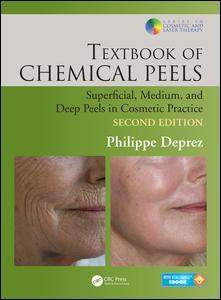Description
Textbook of Chemical Peels (2nd Ed.)
Superficial, Medium, and Deep Peels in Cosmetic Practice
Series in Cosmetic and Laser Therapy Series
Author: Deprez Philippe
Language: English
Subject for Textbook of Chemical Peels:
Keywords
Phenol Peel; Chemical Peels; Demarcation Line; Alpha Hydroxy Acids; Bismuth Subgallate; Trichloroacetic Acid; Full Face Phenol Peel; Phenol; Papillary Dermis; results of chemical peels; Deep Peel; best results chemical peels; AHA Peel; better results chemical peels; Stratum Corneum; technique chemical peels; Peel Solution; TCA Peel; Aha; Grenz Zone; Effective Sun Protection; Glycolic Acid Peel; Superficial Peels; Acne Scars; Glycolic Acid; Kojic Acid; Reticular Dermis; Full Face Peel; Occlusive Mask; Cloudy White Frosting; Local Phenol Peel; Skin Tech; IPL
Approximative price 208.65 €
In Print (Delivery period: 15 days).
Add to cart· 21x28 cm · Hardback
Description
/li>Contents
/li>Readership
/li>Biography
/li>
Chemical peels have returned to the forefront of the practitioner's armamentarium and are popular because they offer nearly immediate results. The Textbook of Chemical Peels is thedefinitive guide to all types of chemical peel treatments. It covers the practical application and scientific background for a wide variety of chemical peels.
The book reflects the new classification of peels as a medical, rather than cosmetic, treatment and helps providers by making chemical peel formulas easier, safer, and quicker to use. The book covers the appropriate selection of peels to treat the face, scalp, neck, hands, body, and forearms. It also discusses the use of peels to treat aging skin, stretch marks, scars, melasma, chloasma, acne, postinflammatory hyperpigmentation, and scalp keratoses.
The mechanism of action, indication, application, and results are discussed for a variety of chemical peels including alpha hydroxy acids, trichloroacetic acid, salicylic acid, resorcine, and phenols. Also covered are any contraindications, precautions, and safety issues. This edition includes new material on adjunctive procedures such as microneedling and mesotherapy as well as new information on mosaic peels.
Treatment prior to and following the peel are also discussed in detail, and a full chapter is devoted to discussing complications associated with chemical peels. The book incorporates color clinical photographs throughoutas well as descriptive tables summarizing key information.Based on the author?s extensive experience in both research and practice, this updated reference is an invaluable guide to all providers involved with chemical peel treatments.
Definition and Classification of Chemical Peels. Prepeel Care. Postpeel Care. Factors Influencing the Skin’s Reactions to Chemical Peels. Selection of the Right Peel. Alpha Hydroxy Acids: Chemistry, pH and pKa, and Mechanism of Action. Alpha Hydroxy Acids: Histology and Factors Influencing Penetration. Alpha Hydroxy Acids: Indications and Results. Alpha Hydroxy Acids: Application as Cosmetics and as Peels. Alpha Hydroxy Acids: Side Effects of AHAs. Alpha Hydroxy Acids: A New Slow-Release AHA Complex with No Neutralization Required. Trichloroacetic Acid: General Information, Toxicity, Formulations, and Histology. Trichloroacetic Acid: Indications and Contraindications. Trichloroacetic Acid: Classic Semiology. Easy TCA and Easy TCA Pain Control: Description and Basic Protocols. Treating Melasma, Chloasma, and Postinflammatory Hyperpigmentation. Treating Acne. Treating Multiple Keratoses on the Scalp. Treating Aging Skin of the Hands and Forearms. Treating the Neck and Décolletage. Stretch Marks, Scars, and Pilar Keratosis: Anterior Chemabrasion. Face and Hands: Actinic Keratoses and Lentigines. Trichloroacetic Acid to the Papillary Dermis: Unideep. Resorcinol: Unna’s Paste/Jessner’s Solution. Phenol: Chemistry, Formulations, and Adjuvants. Phenol: Properties and Histology. Phenol: Skin Penetration and Detoxification. Phenol Toxicity: Causes, Prevention, and Treatment. Phenol: Choice of Peel and Combination Treatments. Phenol: Indications. Phenol: Contraindications, Precautions, and Safety. Phenol: Prepeel Preparation. Full-Face Phenol: Nerve Block Anesthesia and/or Sedation. Full-Face Phenol: Application. Full-Face Phenol: Postpeel Care. Phenol: Chemical Blepharoplasty and Cheiloplasty. Complications of Chemical Peels. Combination Peels.
Philippe Deprez, MD, Clinical Hera, Empuriabrava, Spain
These books may interest you

Step by Step: Chemical Peels 47.10 €



